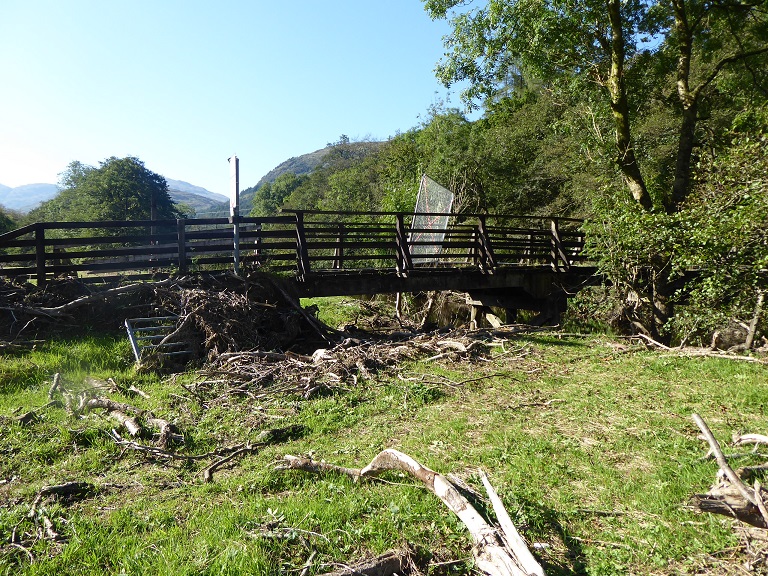
On Friday I, along with many other adults, joined the student inspired climate “strike” in Glasgow. Protest is essential and being out on the streets with so many other people was indeed inspirational. There is no doubt many people want change and urgently. As, however, the police helicopter hovered over George Square gobbling up carbon, spraying us with particulates and drowning out the speeches I reflected we have a long way to go. I tried to imagine the police, who had been deployed in force and some of whom appeared to support the protest, turning up by train or even electric van. As soon as the last marcher entered George Square, the traffic was allowed back in, protected by a discrete line of “law and order”. Even if any protester had been inclined to lie down in the middle of the road, they wouldn’t have lasted a minute.
For all the fine words of people in power saying how inspirational young people have been, there is very little sign of government at any level acting as if its a climate emergency. That would mean government starting to act in the interests of the many and intervening to re-design our entire system. That, as George Monbiot argued in a fine article last week (see here), would mean tackling the very rich who produce far more carbon emissions than anyone else. When he became Prime Minister, Churchill didn’t piss around waiting for markets to deliver, he and his government re-organised Britain in the name of the war effort. Imagine Churchill, for all his faults, declaring a climate emergency and then in the next breath saying we had 26 years to deliver! 2045 is the Scottish Government’s new target for net zero emissions, a target which fails to include all the carbon emissions we have created elsewhere, in places like China, through outsourcing much of our manufacturing industry. Our leaders have been both dishonest and ineffectual
I have been meaning to undertake a series of posts about what our National Parks, which form just part of our country and a small part of government, could and should be doing to address climate change for almost a year. A trip to Glen Falloch on Saturday, prompted in part by a wish to look at the flood damage caused in August (see here), illustrates some of the issues that URGENTLY need to be addressed in just one small part of Scotland. Its a huge task but a much lesser one than winning the second world war which was completed in just 6 years. We need to be inspired but determined.
The West Highland Line and the National Park
A climate emergency doesn’t mean people have to stop enjoying themselves. On the contrary it should mean people spending more time with other people and in nice places instead of consuming plastic. Walking or cycling, whether in towns or the countryside, are not just good for physical health, they provide ideal opportunities for people to enjoy life without consuming lots of carbon. The problem is the getting there. Transport contributes, according to the latest Scottish Government figures, 14.9% of our net carbon emissions and most of this is produced by car. The question is how do we enable people to enjoy the National Park without using cars?
I share a car but have more or less stopped using it entirely in Glasgow where I stay. I still use it to get out in the countryside and, while I have used the bus to walk sections of the West Highland way, more often than not have accessed the Glen Falloch area and the hills round about by that polluting tin box on wheels. On Saturday, I was inspired, carless and the bus was fully booked. It all helped prompt me to try the train for a day out in the National Park.
Having acquired a Senior Railcard fairly recently, the train has become a far more affordable proposition. A return to Crianlarich was £18 instead of £27. That was reflected by the people on the train, younger people, older people and families, all of whom qualify for railcards. Apart from that it was mainly tourists. If you fall into the category of working adult or there are a group of you, the rational decision from a financial perspective is to drive to the National Park if you can. That’s the first thing we need to change.
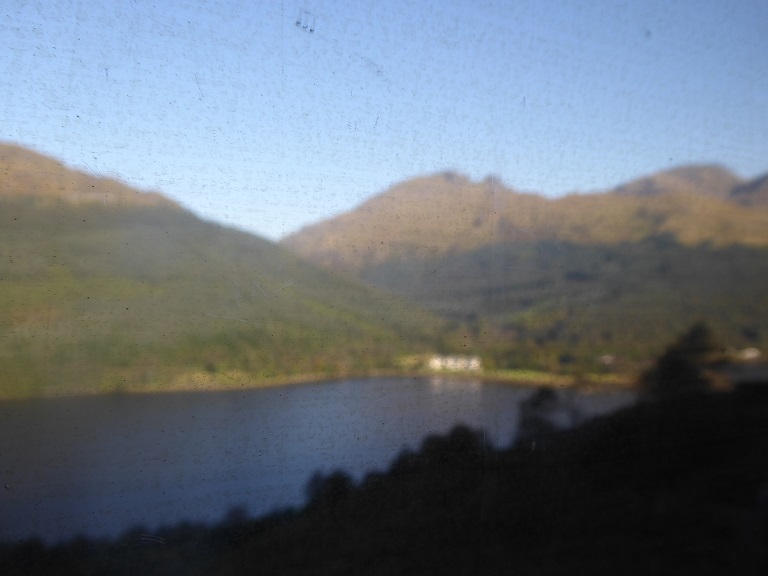
The train is also at present perceived as less convenient than the car. This is partly because it takes longer, assuming the roads are clear. In fact on Saturday I calculated that there would be so many cars on the A82 that, even if bus tickets had been available, I would be better going by train. An hour and a half on the train plus a 25 minute bike ride to Queen Street Station compared to what? I could, so I thought, sit and read and enjoy the unique views from the West Highland Line.
The train was old and seating space cramped. So why, one might ask, has the Scottish Government recently allow Scotland’s one rail engineering facility to close with the loss of 120 jobs (see here)? Why wasn’t the St Rollux works commissioned to re-fit these trains and make them more attractive for travel? That would probably mean re-nationalising the entire railway system, complex perhaps but would Churchill have blinked? That’s the second thing we need to change.
There can be no excuse, however, for the filthy windows. Both Abellio and Transport Scotland should be ashamed. Tourists unable to view our “world beating” scenery. How the management of either organisation tolerate this is difficult to understand – I can only assume they travel everywhere by car. That’s the third thing we need to change, management needs to seriously engage about improving the rail experience.
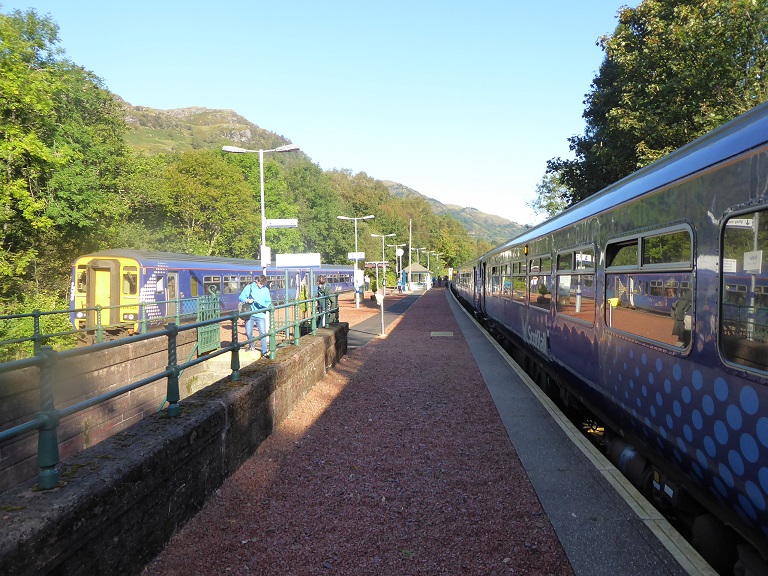
The fourth thing we need to change is the timetable. The first train out from Glasgow is 5.20 am, far too early to be much fun, the second at 8.23 which gets you up to Ardlui just before 10am, quite a late start for hill walking, even for the northern route up Ben Vorlich which starts close to the station.
There are in fact just 6 trains a day at present from Glasgow to Crianlarich. At the end of the day I met a woman at the Crianlarich station who had been walking over Beinn a Chroin and An Caisteal and got back to the station to see the 5.30pm train just pulling out. She had then had to wait two hours for the next train. All of this could be easily changed however. At present the Glasgow train splits at Crianlarich, with some carriages going to Fort William and some to Oban. There is enough rolling stock basically to double the trains between Glasgow and Crianlarich from 6 to 12 a day. That would make rail travel far more attractive for visitors – and indeed would help people living in the Arrochar and Tarbet area. So why not just do it? Its a climate emergency after all and would create more worthwhile jobs.
Unfortunately, the Loch Lomond and Trossachs National Park Authority which should be thinking about these things and shaming Transport Scotland and our politicians into taking action has failed to do anything significant over the last three years. This extends from its failure to respond to the consultation on cycle space on the West Highland Line (see here) to its active encouragement of cars into the National Park through the planning system, the latest example of which is the 449 new car parking spaces associated with Flamingo Land. These, it claimed in the report that was due to go to the Board tomorrow before Flamingo Land withdrew the application last week, are quite compatible with sustainable travel (I will cover this further in another post).
Path connections from the railway
One of the challenges of traveling by train is that the number of stops are limited and are not necessarily close to where you might want to walk or visit. In many places, such as Glen Falloch, its generally much more convenient to travel by car. For certain hills, however, the railway stations are ideally located: Cruach Tairbeart at Tarbet and Ben Vorlich at Ardlui.
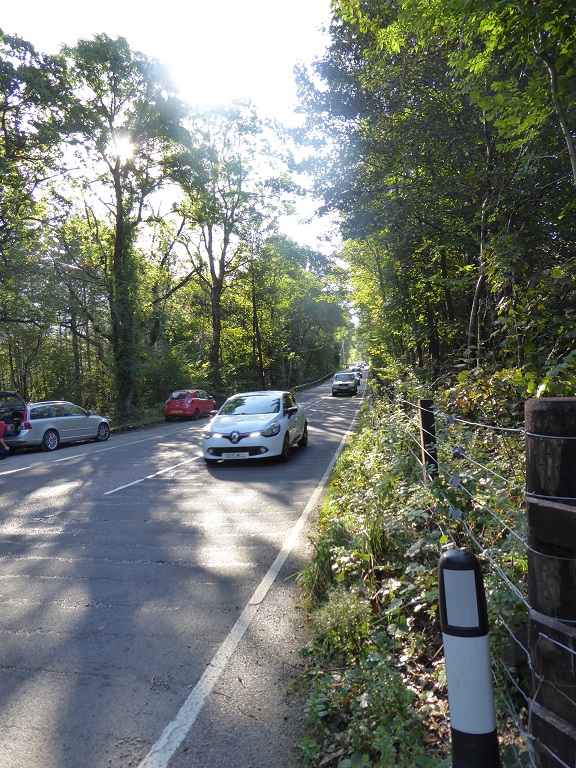
The most popular northerly approach to Ben Vorlich is by Stuckendroin Farm but requires a 200m walk along the A82 from Ardlui whether you arrive by car, bus or train. There is no path and no space to walk by the road so you are forced to walk along the carriageway. I was right about the amount of traffic on the A82 on Saturday, the fine weather forecast had brought dozens of people out to enjoy the National Park. That made walking along this section of road feel even more dangerous than last time I did it (in winter a couple of years ago).
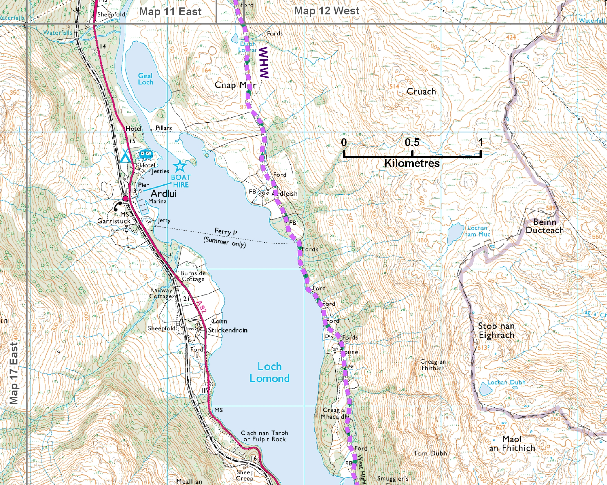
There is not a single core path linking Ardlui with anywhere else and none were proposed in the LLTNPA’s consultation on their revised core path plan earlier this year. That consultation and its outcome has been much delayed but is due to be considered by their Board in October.
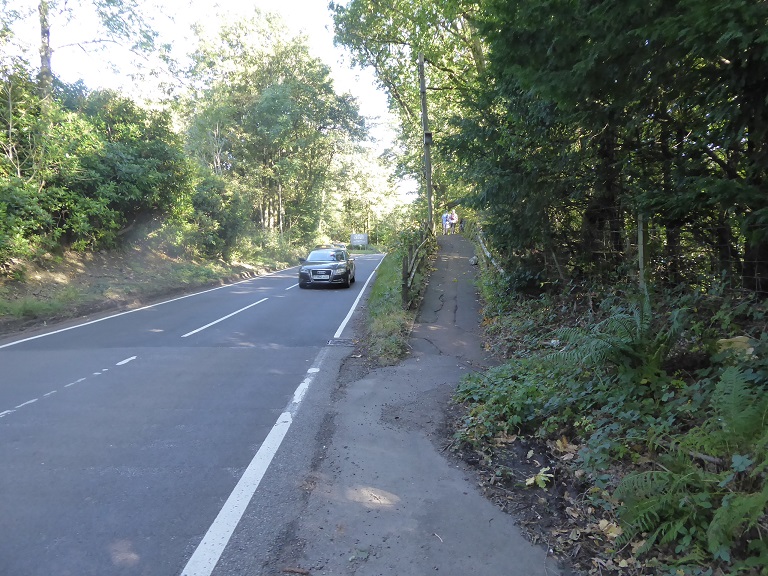
After the marina, there is space to walk by the side of the road for a bit – not pleasant but reasonably safe and enough people have done so to create a path of sorts::
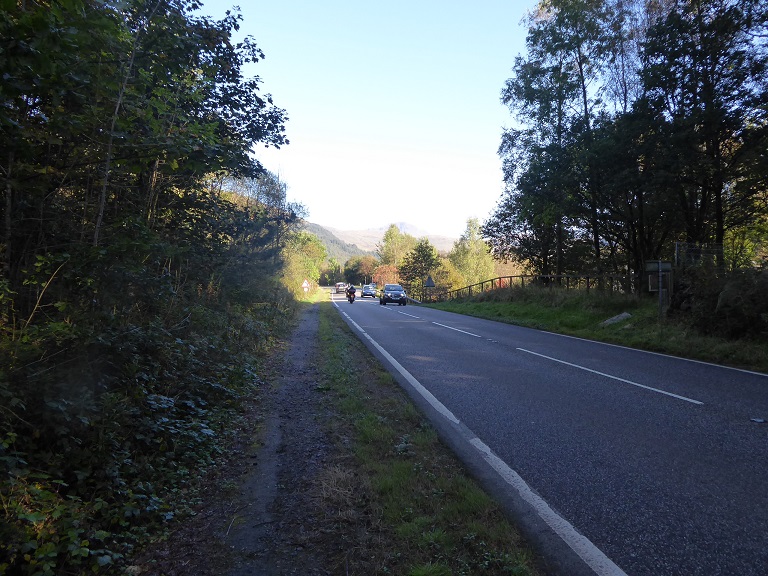
Then, after the abandoned and increasingly derelict former outdoor centre – which could have been easily accessed by train …………….
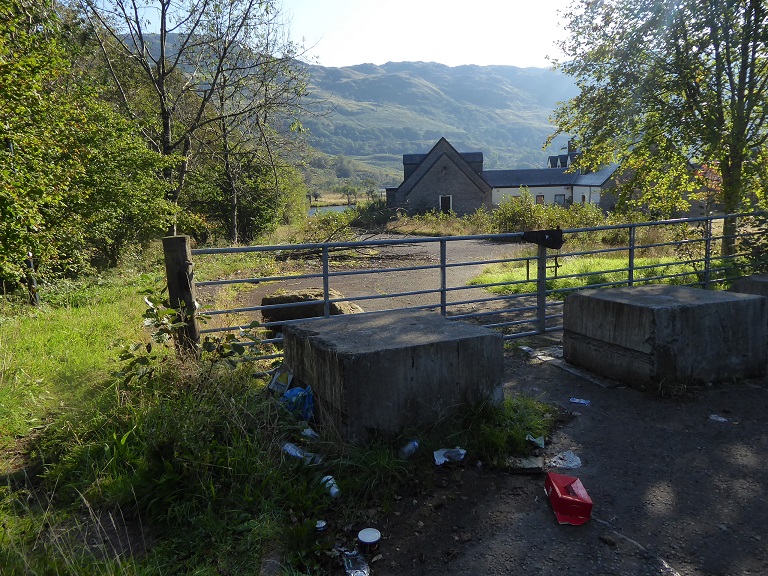
The road narrows just beyond a layby:
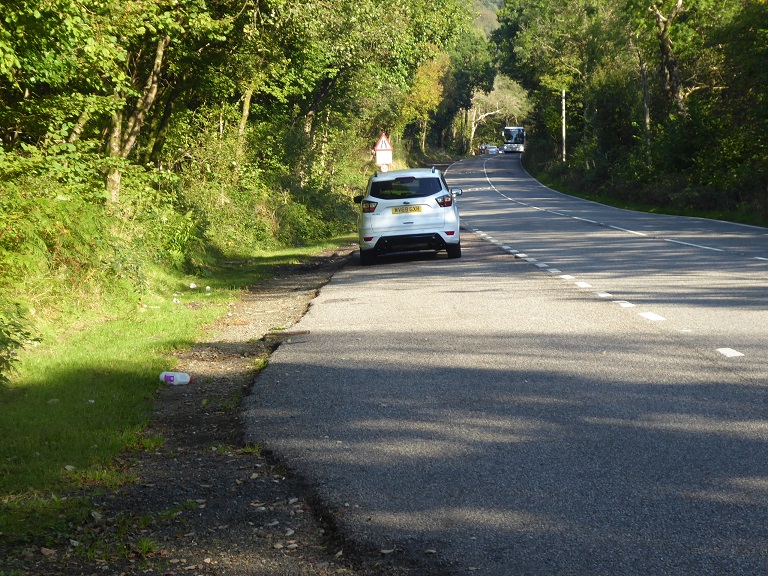
Beyond, there is no path and very little verge all the way to Inverarnan:
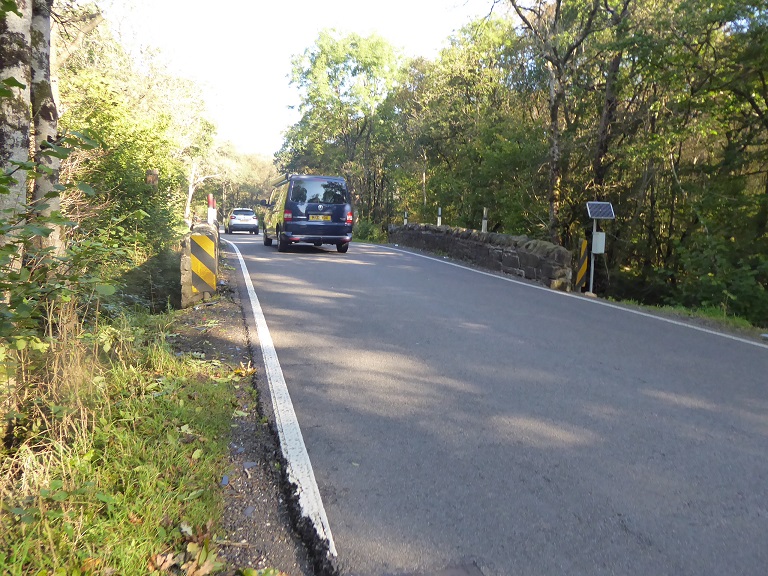
Whether walking or cycling it’s a shocking experience which no-one in their right mind would choose to do. Now you might not want, as I did, to travel the additional three kilometres from Ardlui to Inverarnan, from where you can normally have a gentle saunter to the Eagle Falls or the old canal, walk the West Highland Way or access a number of hills, on foot as it adds quite a bit the day. However, imagine a good bike path here and you could, in a day, quite easily access all the Glen Falloch hills by a mixture of train and bike.
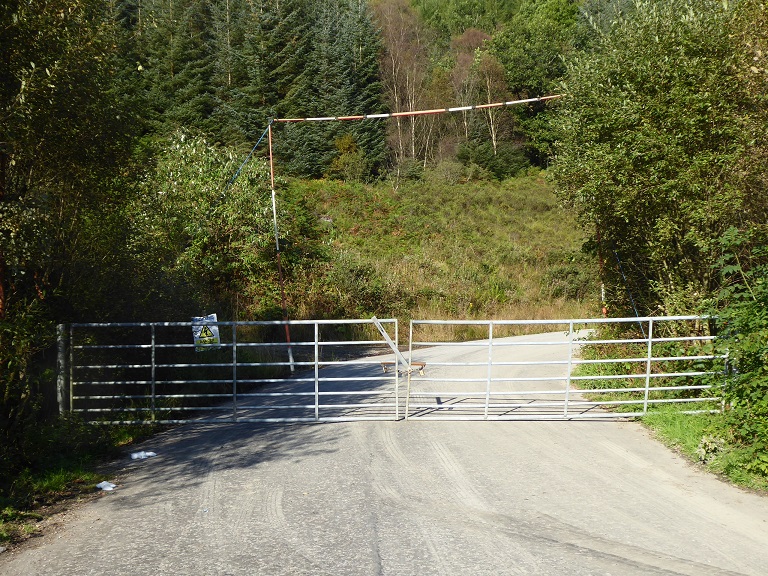
Beyond two narrow bridges, I escaped the dangers of the A82 and tried a track which connects to the Garabal Estate (see here) and the electricity sub-station behind Inverarnan.
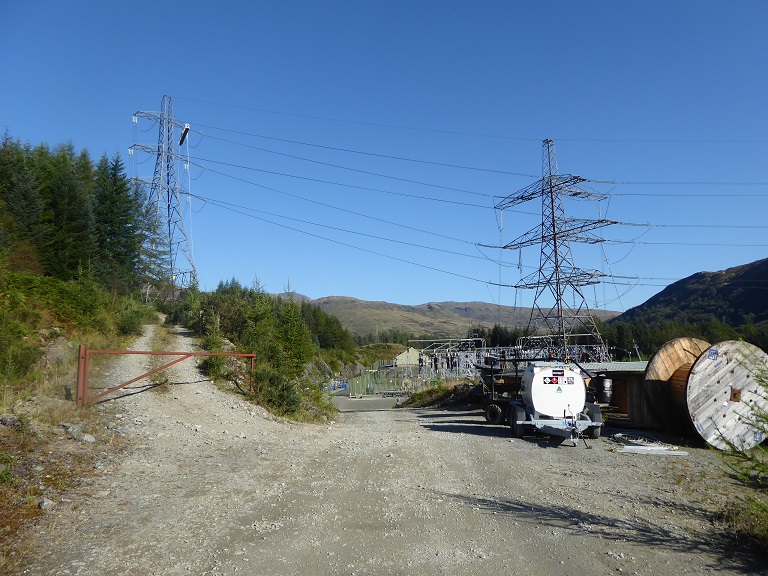
Unfortunately the track doesn’t connect directly with the Drover’s Inn at Inverarnan and there were a couple of hundred metres of very hard going after the power station which are not practical with a bike. While the route is not attractive and is being used for upgrading the national grid at present it could, however, provide the basis for creating a new off road path between Ardlui and Inverarnan in future.

Unfortunately, the LLTNPA’s core path plan is based on designating EXISTING well used routes, not on creating new paths where they are NEEDED. There are ten selection criteria (see here) which, as I have previously argued (see here) lack all ambition. Those criteria now need to be urgently reviewed in the light of the declaration of the Climate Emergency. It should be obvious to all that the LLTNPA needs to re-consult now on ideas about where NEW paths might help to reduce transport emissions and adjust their criteria to enable a path network to be created that is fit for the purpose.
After the Drover’s Inn, which to its credit provides free car parking to hill walkers and other visitors, there is section of dedicated path to Beinglas Farm which is well used by walkers:

So why can’t a similar path connect Ardlui and Inverarnan? Part of the answer is that the upgrading of the A82 to carry yet more cars is a much greater priority to Transport Scotland and the Scottish Government than trying to create the sort of path networks that would enable people to leave their cars at home.
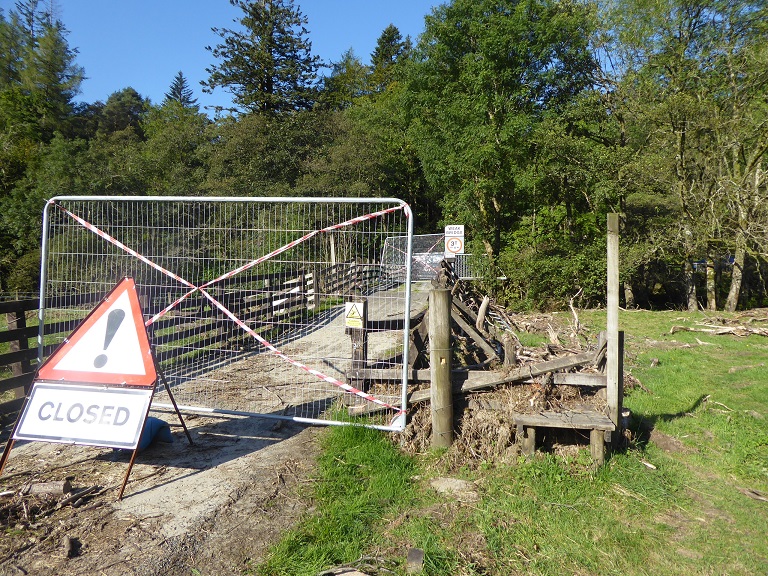
I had not appreciated that the bridge at Invernan had been “closed” due to flood damage. There appears to have been little publicity about this. There is nothing on either the Beinglas farm website (see here) or the news section of the LLTNPA website – an opportunity lost to make people more aware of the sort of damage that appears likely to become more common if we continue to drive cars as we do at present.
I, like others, climbed past the barriers wondering whether the bridge really needed to be closed to pedestrians? Two West Highland Way walkers whom I met later on had walked up the A82 to the next bridge over the River Falloch. They were mightily relieved to get off the road.
What I saw then, during a stravaig over the hills and via hydro schemes will be subject of my next posts. I ended up at Crianlarich station which has much better connections to Glen Falloch than Ardlui. You can either follow the West Highland Way south to Derrydarroch, a slightly round about route which takes you to the centre of the glen, or there is a broad and walkable verge along the A82 to the upper part of the Glen and hills like Cruach Ardrain.
There were a dozen or so walkers who got on the 7.30pm train from Crianlarich back to Glasgow. There will have been more on the bus of course, but how many in total compared to those arriving by car? That’s what we need to change.
What needs to change – the camping byelaws for a start
I don’t blame anyone for travelling by car, I do it myself, but we need to make it easy, indeed possible, for people to change how they access our National Parks. That means improving our public transport system – starting with the infrastructure we have already got like the West Highland Line – and then ensuring it joins up with where people want to go. This post has illustrated just how far we are from achieving that at present in just one small place in Scotland.
The LLTNPA has a legal duty to promote public enjoyment of the countryside, conservation and sustainable development. It could, if it had the will, play a key role in making the National Park more accessible while reducing carbon emissions. For that to happen, however, it needs to consider systematically how to change the balance between public transport and private car use and as this post suggests, literally dozens of actions are likely be required.
That is a huge challenge. The LLTNPA, however, has a significant staff resource that could be deployed to consult and plan on just this, its Ranger Service. The trouble is they have been used to do the wrong things, to try and implement the camping byelaws instead of getting the right infrastructure installed and moving on to something else – like Climate Change.
I saw yet more evidence to illustrate the failure of the camping byelaws on Saturday:
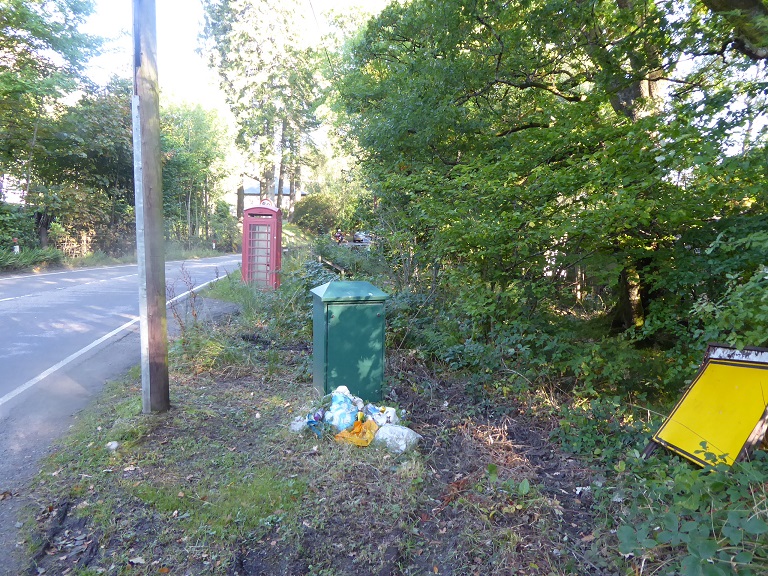
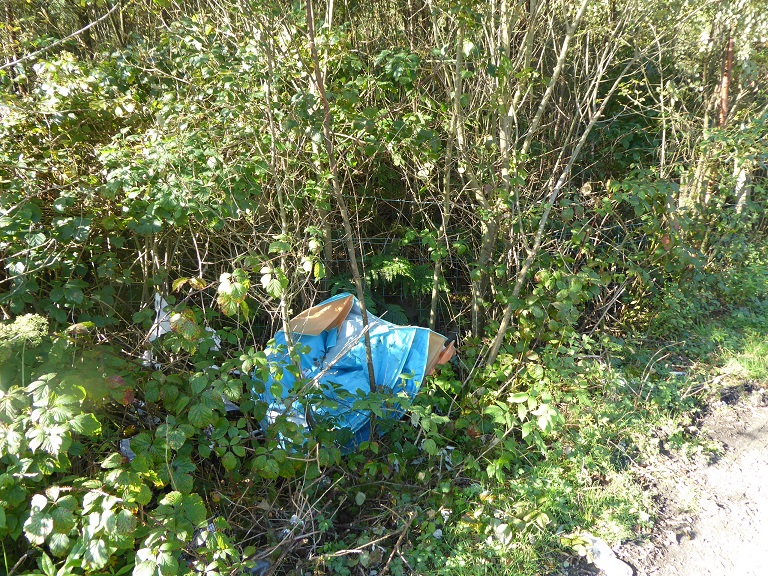
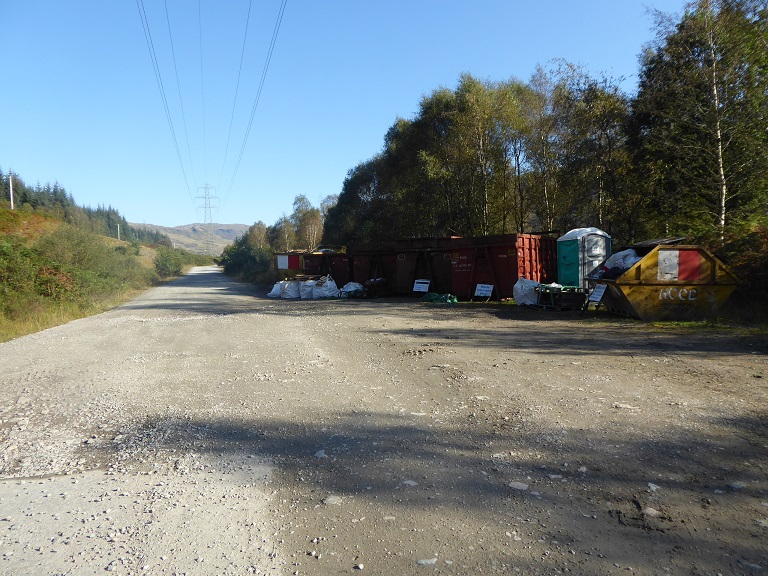
The Scottish Government has declared a Climate Emergency. The LLTNPA has staff who have the skills and knowledge that could help start to address that emergency – working in real rather than pseudo-partnerships – but that will never happen until it fundamentally re-thinks what it does. It needs to ditch the camping byelaws and use its staff to address the issues that threaten us with extinction.
This echoes the attitude of many when the NP was starting up from 1998…to make it a “Green Place” centre of excellence. Now everyone is talking about a “Green Industrial Revolution.” What are the chances of that happening so long as the NP remains wedded to neo-liberal “Cloud 9” politics and economics…when things only get done waiting on some sugar-daddy with a get rich quick scheme coated in green wash? Imagine the Beeching Axe didn’t happen in the 1960’s and the rail network was maintained and supported across Britain and Ireland for the last 60 years. The road users lobby robbed everyone of that future and now we’re going to pay a mint to clean up the mess they made. Monbiot/Guardian are imperialist warmongering rabid liberal interventionists. The military are the highest polluters. I wouldn’t pee on Monbiot/Guardian if they were on fire. This “Greta” thing is a big business mass marketing scam….see Cory Morningstar fb @elleprovocateur on Twitter.
James, I agree with you totally about Beeching cuts, neoliberal economics etc – we should be investing in electrifying the West Highland Line – and share your wariness about putting our trust in “saviours” who more often than not get used and like us all make mistakes/don’t always get things right. Scepticism is good but so also is dialogue and both Monbiot and Thunberg are saying some important things. Whether Thunberg will survive the attention of all the people now trying to use her for their own purposes is another matter – the pressure on her must have been incredible. There are rather different pressures, which are designed to serve the same end, put on people like Monbiot https://www.monbiot.com/2019/07/08/owned/, Jeremy Corbyn (for refusing to see Remain/Brexit as the defining issue in British politics), Ross Greer(for daring to criticise Churchill) etc. I may not agree with all they say but we need people in the public eye who are prepared to stand up for something.